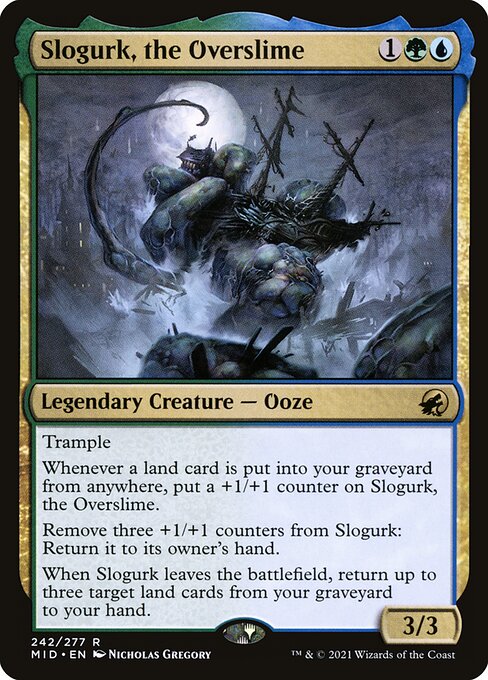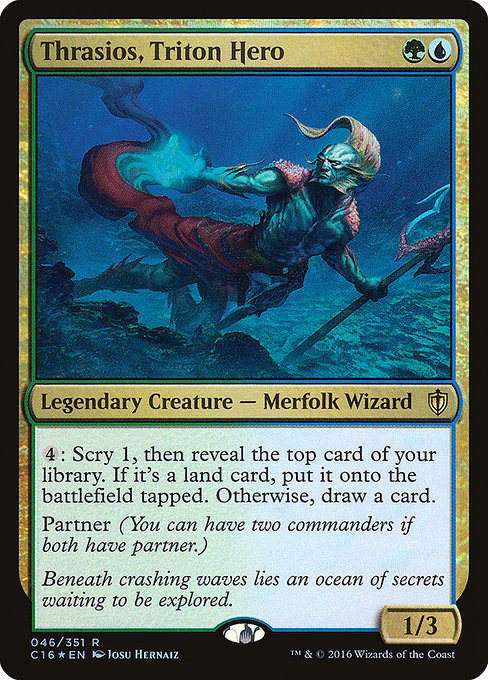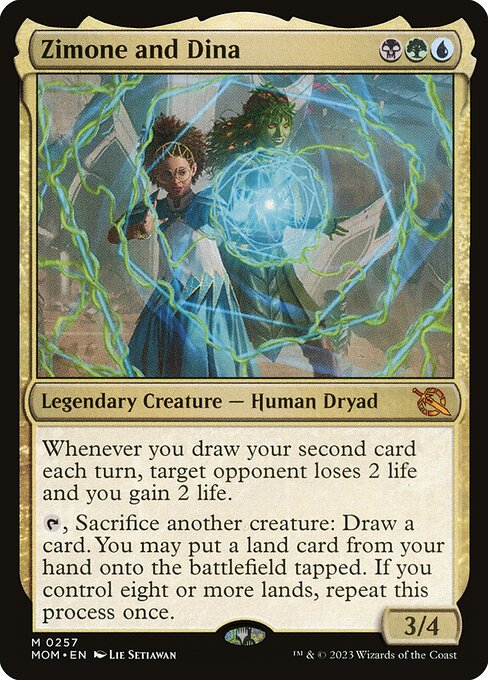I usually get excited about a new idea and then write an article about it, then move on to playing with it and iterating on it. That means the articles are snapshots of an early time in my process, and the decks I write about are weak.
An aside on that. This isn’t a strategy column and this isn’t a strategy site. I assume if you’re looking for a tournament-winning cEDH deck, you’ll look for cEDH tournament results. I’m writing about my process and sharing some ideas I hope will offer new perspectives.
There’s a decent amount of gatekeeping around cEDH. “That’s not cEDH” because it’s not a “database deck” or something like that. To me, if you’re trying to win and you want your opponents to also try to win, that’s cEDH. The only thing that bothers me in cEDH is when someone gives up as soon as they fall behind. I tolerate it, but I prefer games where everyone’s really committed.
I don’t think any of my decks are better than the best established cEDH decks. But, I do think my process is good. I expect to build decks which have real strengths other decks don’t have. I also think trying decks designed to do a thing I want, and then seeing exactly how and why that thing doesn’t work, is the best way for me to learn to evaluate other decks.
That said, I do think I’m reaching the point where playing more with thoroughly explored “optimized” lists would be good. I’m actually in the process of putting together “stock” Gitrog monster right now. I hear it’s not necessarily held in super high regard, but it looks strong and very interesting to play to me, so I want to try it out. It’s also built in a way that’s pretty alien way, such as more “bad” tutors. But it’s likely right for what it is: a roughly 1.5 card combo deck with its commander in play.
I’ve played some with the decks I’ve written about, and I’ve identified where they went wrong and whether or how they could be improved.

Ironworks in Izzet
First, Jhoira, Ageless Innovator, which I wrote about here my first deck. This is also the deck I played most before writing about it, and, not coincidentally, I think it’s the best. Different Commanders try to break different aspects of the game engine. I think breaking mana is generally better than breaking card draw. Jhoira is similar to commanders like Magda, Brazen Outlaw and Selvala, Heart of the Wilds in that way. Jhoira and Magda both also break the stack by putting threats directly onto the battlefield.
Jhoira has a great mix of interaction between really strong stax artifacts and counterspells. Its Krark-Clan Ironworks combo is slow to assemble, but it plays a good interactive game and gets a lot of ~1 card wins with Portal to Phyrexia or Knowledge Pool. I’ve largely run out of ideas about how to substantially improve it, because it performs well. I should probably find room for Tangle Wire, but that’s about it.

The Steps Along the Way
I wrote about trying to improve on Raff, Weatherlight Stalwart, but I haven’t felt like I’ve found an approach I’m happy enough with to capture my interest again. Battle for Segovia, See Double, and Transcendent Message are interesting cards for the deck, but I haven’t really taken a serious stab at it.
I wrote about Hidetsugu and Kairi, and concluded quickly it’s just remarkably bad. Not being able to play your commander until you’re set up to go for a win is a huge disadvantage that makes it really hard to compete with grindy commanders. This isn’t a stronger “my commander is part of my combo” combo piece than The Gitrog Monster or Tivit, Seller of Secrets.
If I want to play a Dimir Combo deck, I think I’d be better off with Rona, Herald of Invasion or Vohar, Vodalian Desecrator. This would be so I had a cheap commander which could help set up my combo while advancing my game over time.

Lands and An Ooze Which Wants to Bounce
Next. I wrote about Slogurk, the Overslime here
This deck is in a bit of a weird space. I think it’s a bit slow to get rolling for cEDH, but at the end of Command Fest Minneapolis I was looking for a commander game. They had signs for players looking for Casual, Competitive, or “all.” I was looking for a competitive game, but everything was closing soon and all I could find were some players looking for “all”–I figured that probably meant high powered, so I joined with Slogurk. It felt kinda bad.
The game quickly turned into an exhibition match where I was just demonstrating the ridiculous things my deck could get up to when given some time. I’m talking Carpet of Flowers against a mono blue player while I had Null Rod shutting down the table. It turned out they were very new players and probably should have had a casual sign. I think the deck should be expected to play reasonably against “High Power EDH.” I think there’s room to improve it by figuring out which combos are best and focusing on those. It could drop some other possible backup plans, but I kinda got interested in Zimone and Dina, which I think occupies a similar role and moved on to that

Leaning Into Partners
I was really optimistic about my idea for Tymna-Thrasios Stax, explained here, but was a bit disappointed in playing with it.
I wanted to see if I could hard lock the table and win in combat. The answer is that hard locking the table is very difficult. Stax pieces are great at slowing people down, but they’ll eventually find an answer. They largely have diminishing returns–additional pieces don’t seem to make the puzzle that much harder to solve. There’s kind of a fixed amount of time it takes people to find their way out, and additional pieces don’t reliably extend it much.
There’s also a problem where winning through combat tells people exactly how many turns they have left, and when they know they’re about to lose. They have to try to win, and while that’s usually not going to result in them winning, too often in can clear the way for the next desperate player to win before I can end the game in combat.
My deck was built as Tymna Stax with Thrasios for colors, but if I reduce some of the stax element I can lean into the Thrasios element a little. Thrasios is a great commander because it gives you a mana sink in the command zone. This means any of many two card infinite mana combos generally need a third piece to actually end the game. But you only need two pieces when you have Thrasios.
I don’t like what I call “high exposure” combos–combos where you lose if they’re answered like Thassa’s Oracle or Doomsday–I like the idea of being able to present a win when you don’t know if it will resolve, and just continuing to play the game if it doesn’t. Devoted Druid and Swift Reconfiguration, for example, is as cheap as Thassa’s Oracle and Demonic Consultation, but there’s no window for the right answer to make you lose. Worst case you’re just down two cards. For most decks, Devoted Druid and Swift Reconfiguration isn’t a particularly useful combo because infinite green mana doesn’t do anything, but with Thrasios, it’s trivial to turn that into winning the game. This is where something like Finale of Devastation comes in.
Tymna-Thrasios is a great home for these low exposure/safe combos without fundamentally changing the core strategy.
So my idea was to play fewer stax pieces, more proactive combos, more counterspells, and to remove the Rule of Law effects. Those have a lot of negative interactions with a game plan that revolves around drawing tons of cards.

Moving Forward
This deck is still very much a stax/fair deck, but with a bit more of a plan. Again I’m cautiously optimistic about it.
Next I wrote about Zimone and Dina, and this deck, like Slogurk, was just too slow. I went too far in my “Lands commanders should play lots of lands and therefore not ramp” and my “Collector Ouphe and Null Rod wants no artifact mana.”
I’ve rebuilt this to remove most extraneous combos and really focus on getting Zimone and Dina onto the battlefield.
The deck’s goal is to get Bloodghast in the graveyard, then either find Quirion Ranger or Retreat to Coralhelm. With Quirion Ranger, you get to draw a card on everyone’s turn, then go wild once you have eight lands. With Retreat to Coralhelm, you basically get to Cultivator Colossus whenever you have a land, and then draw your deck when you find a bounceland. I added the Thassa’s Oracle combo as a way to maybe steal the odd game, and increased the counterspells some. It’s possible Praetor’s Grasp and Mnemonic Betrayal are glaring omissions, and also possibly I should be playing them instead of Thassa’s Oracle and Demonic Consultation.
I called the new build Turbo Zimone and Dina
I’m not sure if, as the Gitrog primer suggests, Gitrog is the only viable lands deck. Or, whether the Zimone and Dina combos plus her their natural mana, card advantage, and access to blue cards gives them a reasonable chance.
I look forward to continuing to learn, improving my cEDH decks, and improving my cEDH deckbuilding, and it’s nice to be able to show the progress I’m making.
Sam Black (any) is a former professional Magic player, longtime Magic writer, host of the Drafting Archetypes podcast, and Twitch streamer. Sam is also a Commander Cube enthusiast, and you can find Sam’s cube list here. For anything else, find Sam on Twitter: @SamuelHBlack.

